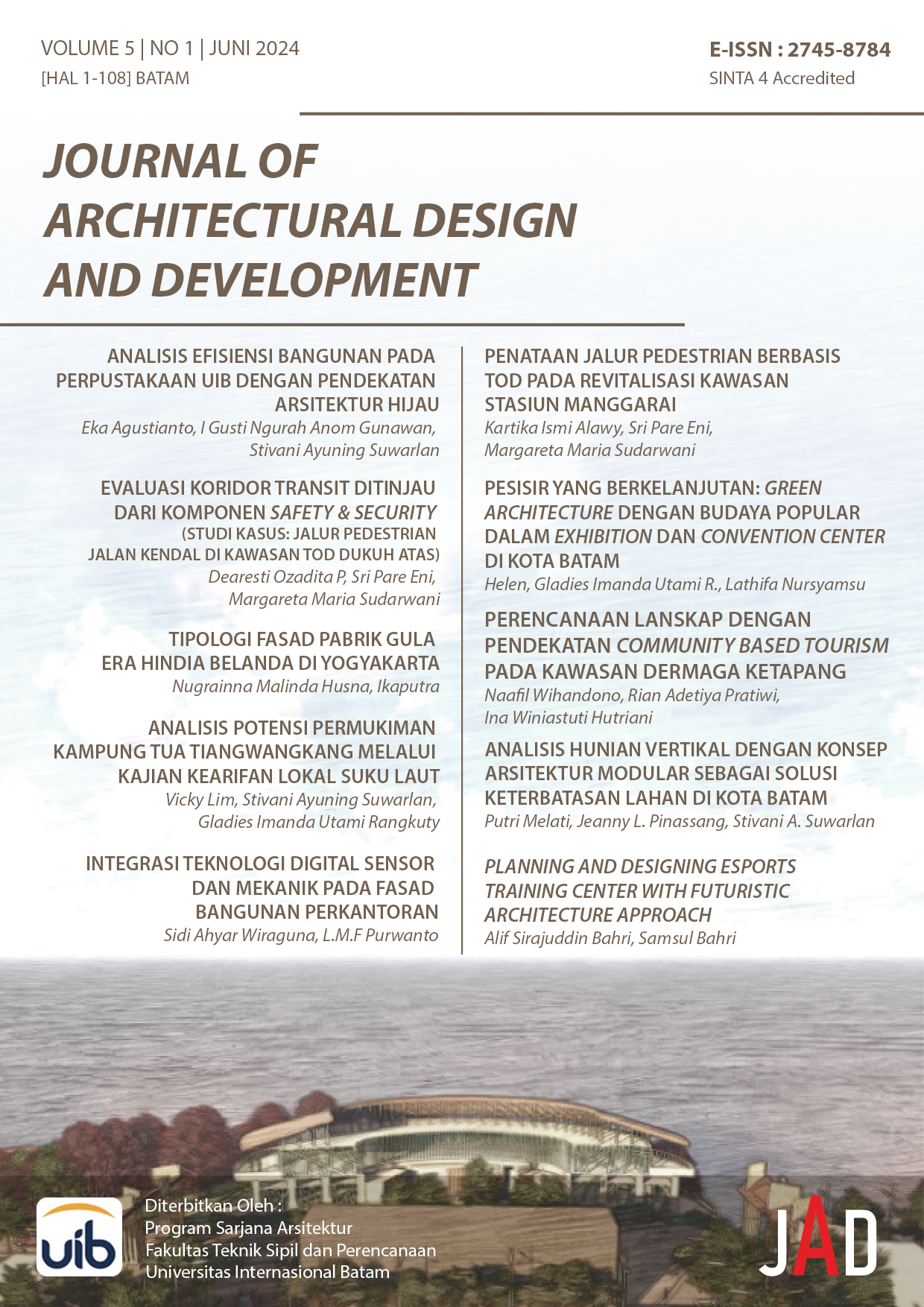INTEGRASI TEKNOLOGI DIGITAL SENSOR DAN MEKANIK PADA FASAD BANGUNAN PERKANTORAN
DOI:
https://doi.org/10.37253/jad.v5i1.9124Keywords:
integrasi teknologi, digital sensor, mekanik, fasad bangunanAbstract
In an era of climate change and demands for environmental sustainability, office building facades face the challenge of responding efficiently to changing weather conditions. This research aims to integrate digital and mechanical sensor technologies in facades to create responsive systems, increase energy efficiency, and improve occupant comfort. Using a mixed methodology involving literature analysis, case studies, and computational simulations, this research explores the potential of dynamic facades in responding to environmental variables such as temperature, lighting, humidity, and noise. The results show that the integration of sensor and mechanical technologies enables the facade to dynamically adjust to external conditions, reduce the energy load on the building, and improve thermal and visual comfort for occupants. Furthermore, this research identifies design strategies that can be applied in the development of responsive office building facades, focusing not only on aesthetic aspects, but also on the function of adaptation and interaction with the environment. The conclusion of this research shows that the use of sensor and mechanical technologies in building facades is a significant step forward in digital architecture, with great potential to increase energy efficiency and improve the quality of life in office environments. This research makes an important contribution to the literature in the fields of digital architecture and sustainable development, offering new insights into responsive and adaptive building façade design. The implications of the findings point to new directions for the development of building facades that are more interactive and responsive to their surroundings.
Downloads
References
Alfian, W. O. (2018). Pengaruh Fasad Terhadap Kinerja Energi Pendinginan Pada Kantor Pemerintah Di Surabaya (Tesis). Institut Teknologi Sepuluh Nopember, Surabaya.
Al-Kodmany, K. (2023). Greenery-Covered Tall Buildings: A Review. Buildings, Vol. 13 No.9, 2362.
Bayu, B., Anandhita, G., & Purwanto, L. M. F. (2019). Penerapan Rancangan Fasad Biomimetik Sebagai Ekspresi Bentuk Dinamis Melalui Metode Pencarian Bentuk Algoritma. Semarang.
Brunoro, S., & Frighi, V. (2024). Smart Façades: Technological Innovations In Dynamic And Advanced Glazed Building Skins For Energy Saving. In Façade Design - Challenges And Future Perspective. London: Intech Open.
Bungin, B. (2011). Metodologi Penelitian Kualitatif : Aktualisasi metodologis ke arah ragam varian kontemporer, Jakarta: Rajawali Pers.
Faragalla, A. M. A., & Asadi, S. (2022). Biomimetic Design For Adaptive Building Façades: A Paradigm Shift Towards Environmentally Conscious Architecture. Energies, Vol. 15, No. 15, 5390.
Halawa, E., Ghaffarianhoseini, A., Ghaffarianhoseini, A., Trombley, J., Hassan, N., Baig, M., … Azzam Ismail, M. (2018). A Review On Energy Conscious Designs Of Building Façades In Hot And Humid Climates: Lessons For (And From) Kuala Lumpur And Darwin. Renewable and Sustainable Energy Reviews, 82, 2147–2161.
Heidari Matin, N., & Eydgahi, A. (2022). Technologies Used In Responsive Facade Systems: A Comparative Study. Intelligent Buildings International,Vol. 14, No. 1, 54–73.
Hendrananta, M., & Rizalsyah Thahir, A. (2019). Penggunaan Sistem Bangunan Pintar Di “The Edge” Amsterdam Dan “Glumac” Shanghai. Prosiding Seminar Intelektual Muda, Vol. 1, No. 2.
Peraturan Menteri Pekerjaan Umum dan Perumahan Rakyat Nomor 22/PRT/M/2018 Tahun 2018 tentang Pembangunan Bangunan Gedung Negara.
Undang-undang (UU) Nomor 28 Tahun 2002 tentang Bangunan Gedung.
Undang-undang (UU) Nomor 30 Tahun 2007 tentang Energi.
Kwa, T. R., & Sari, W. E. (2022). Implementation Of Dynamic Facade Using Temperature Sensor To Increase Indoor Thermal Comfort. Riset Arsitektur (RISA), Vol. 6, No. 3, 332–349.
Larasati, D. (2017). Aspek-Aspek Perancangan Arsitektur Dan Implementasinya. Seminar Arsitektur. Bandung: Institut Teknologi Bandung.
Loonen, R. C. G. M., Trčka, M., Cóstola, D., & Hensen, J. L. M. (2013). Climate adaptive building shells: State-of-the-art and future challenges. Renewable and Sustainable Energy Reviews, Vol. 25, 483–493.
M. Yusuf, & Sodik, M. (2023). Penggunaan Teknologi Internet of Things (IoT) dalam Pengelolaan Fasilitas dan Infrastruktur Lembaga Pendidikan Islam. PROPHETIK: Jurnal Kajian Keislaman, Vol. 1, No. 2, 65–82.
Moran, F., Fosas, D., Coley, D., Natarajan, S., Orr, J., & Ahmad, O. B. (2021). Improving thermal comfort in refugee shelters in desert environments. Energy for Sustainable Development, Vol. 61, 28–45.
Undang-undang (UU) Nomor 32 Tahun 2009 tentang Perlindungan dan Pengelolaan Lingkungan Hidup.
Putra, R. A. (2018). Peran Teknologi Digital dalam Perkembangan Dunia Perancangan Arsitektur. Elkawnie: Journal of Islamic Science and Technology, Vol. 4, No. 1.
Ramzy, N., & Fayed, H. (2011). Kinetic systems in architecture: New approach for environmental control systems and context-sensitive buildings. Sustainable Cities and Society, Vol. 1, No. 3, 170–177.
Reddy, V. J., Hariram, N. P., Ghazali, M. F., & Kumarasamy, S. (2024). Pathway to Sustainability: An Overview of Renewable Energy Integration in Building Systems. Sustainability, Vol. 16, No. 2, 638.
Reme Ibrahim, M. (2024). Perspective Chapter: From Data to Design – Leveraging Façade Sensors for Intelligent Architecture. London: Intech Open.
Sastra M, S. (2016). Kajian Estetika Bentuk Pada Fasade Perumahan Real Estate Di Yogyakarta. INERSIA Lnformasi Dan Ekspose Hasil Riset Teknik Sipil Dan Arsitektur, Vol. 12, No. 1, 78–84.
Sijakovic, M., & Peric, A. (2021). Sustainable architectural design: towards climate change mitigation. Archnet-IJAR: International Journal of Architectural Research, Vol. 15, No. 2, 385–400.
Utilities One. (2023). Climate-Responsive Facades Beyond Traditional Covers, Diakses Pada 7 Maret
, https://utilitiesone.com/climate-responsive-facades-beyond-traditional-covers
Webb, M. (2022). Biomimetic building facades demonstrate potential to reduce energy consumption for different building typologies in different climate zones. Clean Technologies and Environmental Policy, Vol. 24, No. 2, 493–518.
Widyakusuma, A. (2024). Inovasi Arsitektur Dalam Bentuk Fasad Cerdas Bangunan Untuk Mengatasi Polusi Udara Jakarta. TRAVE, Vol. 28, No. 1.
Zhang, X., Zhang, H., Wang, Y., & Shi, X. (2022). Adaptive Façades: Review of Designs, Performance Evaluation, and Control Systems. Buildings, Vol. 12, No. 12, 2112.







